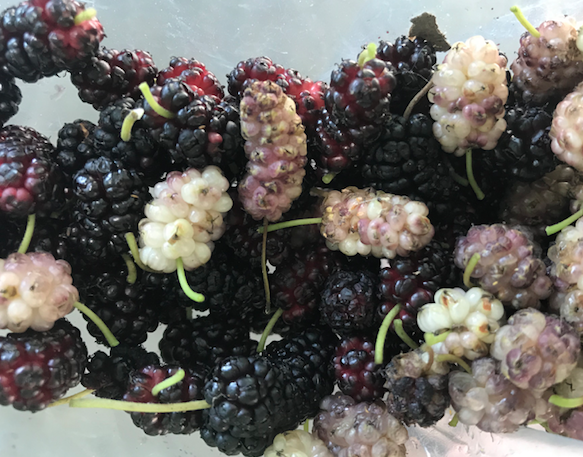The Foraged Berries of June Series: How to Identify and Harvest Mulberries
This year, there is particular comfort in the markings of the seasons that have stayed the same. June is told by berries–mulberries, juneberries, wineberries, strawberries, blueberries. When you know how to look, you can see the abundance everywhere in Maryland– the city, suburbs, and countryside.
In our first blog post of this series, we will demonstrate how to identify and harvest mulberries. Mulberries are purple. red, or white berries that are shaped like black berries, and taste a little more savory, less sour. They can be eaten from the tree after a wash, or baked into pies, cookies, tarts, and jams. There will also be some philosophical musings throughout the series about the “foraging ethic”–the “economy of reciprocity,” as ecologist Robin Wall Kimmerer describes in “Braiding Sweetgrass.” We will also skim some of the history that surrounds these fruits of the season.
Mulberries:
Baltimore City, and Maryland beyond, is home to many Mulberry Trees–purple, red, white, and a lavender hybrid. You might already know the tree by the squishy, fermenting, seed-like blobs on the sidewalk or the driveway, and might have wondered “are these things edible?” Yes, indeed! Mulberries are high in anti-oxidants, and the red Mulberries are native to this region. Squirrels, birds, and other animals love to eat Mulberries for these reasons, as well. You can normally identify a Mulberry Tree by the shape of the leaves:
As the fruit bearing season draws near (which tends to be in June in North America), you’ll start to notice small green berries woven between the leaves. Start keeping an eye out for them during the last week of May, and take some time to observe as the color and shape shift. When the chicory flowers open into their periwinkle umbrella, it is a sign that the Mulberries are nearing their peak of ripeness. You’ll also start to notice that the early Mulberries start falling to the ground.
Mulberries are ripe when they come off the tree easily, when they are plump and at full dark purple/red, or a full white (not bright red or green). The easiest way to harvest is to shake the branches to encourage ripe Mulberries to fall to the ground. Recover the Mulberries by catching them on a sheet or tarp that you either lay out on the ground, or have a few sets of hands holding at the corners. To reap a full harvest, consider inviting a few friends along, a sheet or tarp, and a broom or large stick. This helps you get the Mulberries that are way high up in the tree. In pandemic times, bring people along who you are in quarantine with, or meet up with a friend and keep distance by going to different ends of the trees or different trees nearby each other. Be sure to wear a mask, and have gloves or sanitizer handy. Also, be sure not to over harvest–leave the over-ripe Mulberries, and the ones left to get ripe–for the birds, squirrels, soil, and other people. Though Mulberries are often abundant (you’ll start noticing them everywhere!) it is important to be respectful of the tree and the ecosystem it belongs to (which you are also a part of).
Mulberries are best eaten that day or the next. They have a short shelf life, so the best way to store Mulberries is by freezing them, dehydrating them, or getting right to baking or cooking.
Here are some ideas on how to use Mulberries:
Mulberries grow all over the world, and have a place in most foods and cultures–particularly in cuisines of Indiginous Peoples of North America, and in the cuisines of India and Iran. The white Mulberry is originally from China, and is the preferred home to silk worms. White Mulberry Trees were imported to North America, attempting to impose a silk economy onto the climate and landscape…which, umm, didn’t work. Learn more about their specific history to the United States here.
Cheers to a bountiful harvest and engagement with the world around you! Please post in the comments about your harvest or cooking experience, or tag @marylandnature on instagram in your Mulberry posts!

